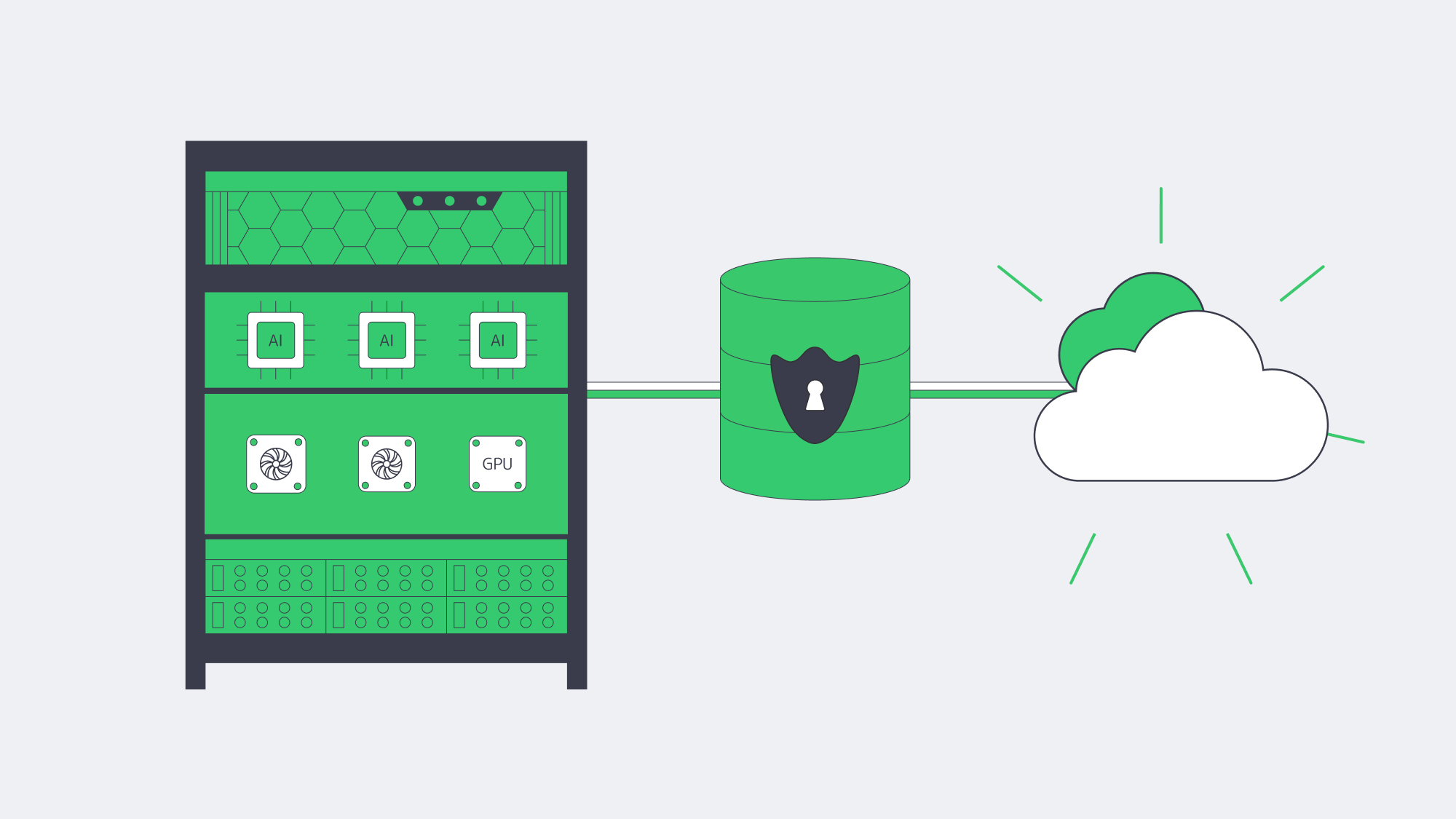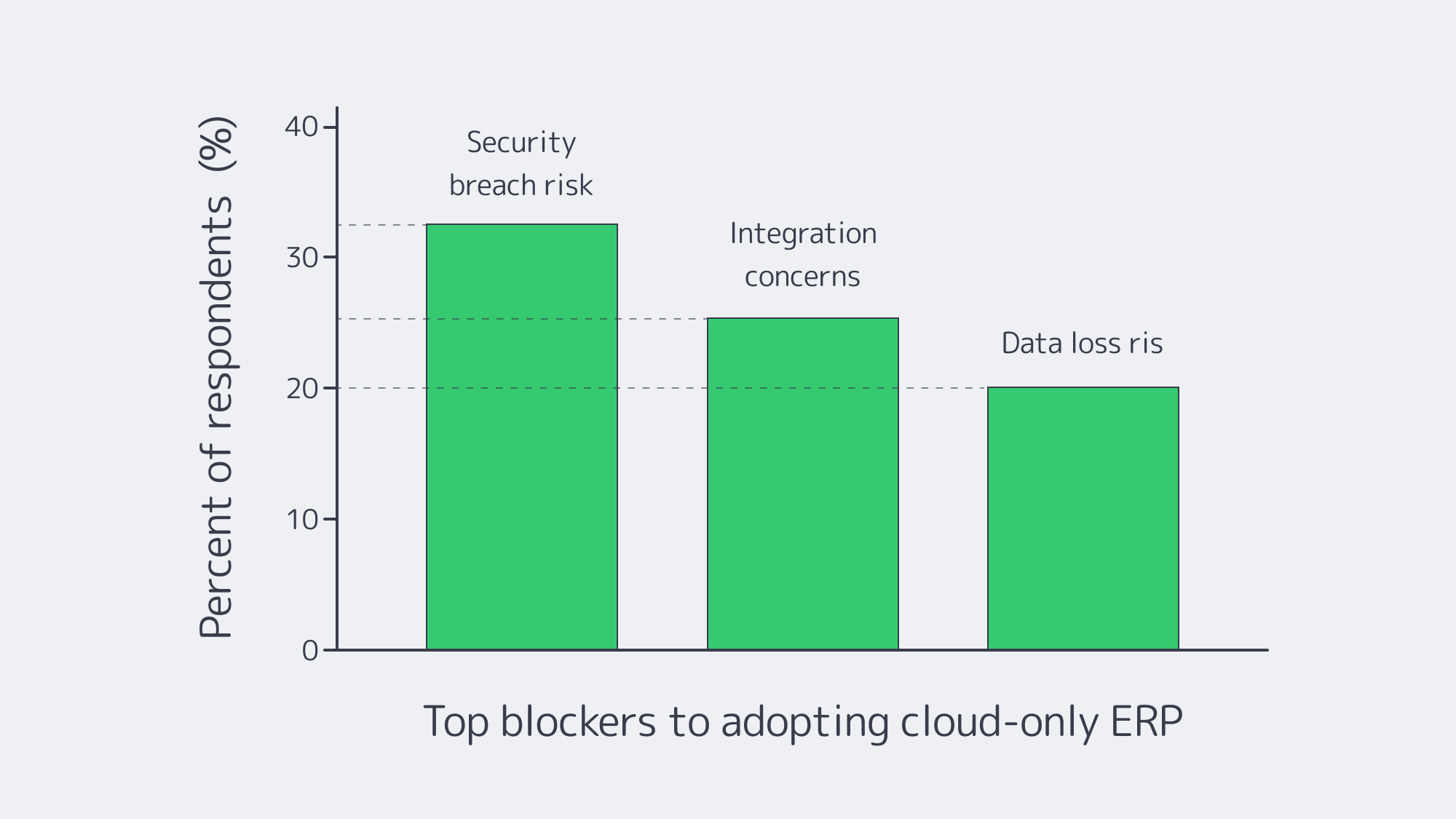Blog

Hybrid ERP Hosting for Cost, Control, and Speed
Public cloud made ERP modernization feel inevitable. But a sharper set of pressures—security and data sovereignty mandates, AI-driven analytics, real-time global access, and ballooning cloud bills—has pushed enterprises toward a more deliberate balance between cloud and dedicated infrastructure. The question isn’t “cloud or on-prem,” it’s how to blend both to get control, performance, and predictable cost.
Why Are Organizations Rebalancing Now?
Three forces dominate the recalculation:
- Cost variability. Cloud’s elasticity comes with opaque pricing. In the latest industry benchmark, 84% of organizations said managing cloud spend is their top challenge; budgets run ~17% over, and waste regularly lands around 30%+ of spend. Those are the very dynamics driving workload-by-workload rethinks.
- Sovereignty and control. New “sovereign cloud” options from major ERP providers underscore how serious data residency and jurisdiction have become. SAP expanded its Sovereign Cloud portfolio—including an “On-Site” model—to let customers keep workloads under local control. In parallel, AWS announced an EU-only operated European Sovereign Cloud to satisfy residency and administrative-control requirements.
- Performance and AI gravity. The further users are from the ERP, the more productivity takes a hit; Amazon’s famous finding—every extra 100 ms costs ~1% in sales—remains a simple proxy for how latency degrades outcomes. Meanwhile, AI features inside ERP (forecasting, anomaly detection, copilots) pull compute to where the data lives, often favoring dedicated machines for steady, high-throughput work.
A clearer picture emerges: cloud remains powerful for bursty or edge use cases, but security, sovereignty, and predictable performance are pushing core ERP components—especially databases—toward dedicated servers or private clouds.
Choose Melbicom— 1,000+ ready-to-go servers — 20 global Tier IV & III data centers — 50+ PoP CDN across 6 continents |
What Pitfalls of Cloud-Only ERP Hosting Matter Most?
- Unpredictable bills and waste. Egress, cross-region traffic, peak autoscaling, and orphaned resources drive overruns. Flexera’s latest data (84% cite spend management as the top challenge; ~17% over budget; ~30% waste) explains the wave of targeted repatriations—moving only specific ERP components where cost and control matter most. Barclays’ survey figure—83% of enterprises planning some repatriation—put a spotlight on the trend (with analysts noting the nuance: some workloads, not all).
- Latency and variability. Multi-tenant cloud is efficient, but “noisy neighbors” and distance from users introduce jitter. Dedicated servers isolate resources and let teams place compute near users (or near regulated data) to reduce round-trips—often the cheapest way to buy back seconds of user time.
- Integration and data gravity. ERP is never alone; it ties to MES/SCM/CRM, data lakes, and print/reporting servers. When source databases sit in one region and analytics or spreadsheets in another, latency and egress fees bite. Offloading reporting to local dedicated nodes (for example, running Epicor Spreadsheet Server against a nearby database) curbs both cost and lag. (Functionally, the same idea applies to a Sage X3 print server kept close to printers.)
- Security posture. Cloud is a shared-responsibility model; misconfiguration remains a common failure mode. For regulated datasets, single-tenant dedicated hardware simplify isolation, auditing, and key custody—and can sit in jurisdictions you control.
What is the Best ERP Server Hosting Mix for Control, Performance, and Cost?
Best ERP server hosting is rarely a single environment. A pragmatic pattern looks like this:
- Keep stateful, sensitive cores on dedicated servers or in a private cloud (your racks or a hosting partner) to meet data residency, performance, and customization needs.
- Use public cloud tactically—for development/test, burst analytics, seasonal closes, or global fan-out of stateless web tiers.
- Place nodes where your users and laws are. Distribute read replicas and app tiers to reduce latency without violating residency policies.
Sovereign-cloud moves by major vendors validate this trajectory. SAP’s sovereign and on-site options acknowledge that for many, control is a feature, not a bug. AWS’s EU-only operation model makes the same point from the infrastructure side.
How Do AI-driven ERP Analytics Change Infrastructure Choices?

- Compute placement. Training and inference against ERP data (forecasts, quality alerts, fraud checks) benefit from high-memory, GPU-capable servers sitting close to the ERP database to minimize data movement and latency. Renting cloud GPUs ad-hoc is useful for spikes; renting dedicated GPU servers is often cheaper for continuous workloads.
- Data governance. Many teams are uncomfortable shipping sensitive ERP rows to third-party AI services. Keeping models next to the data, on dedicated hardware, preserves control and auditability.
This isn’t theoretical: surveys show more than 65% of organizations view AI as critical to ERP, and ~40% say built-in AI features influence ERP investment—evidence that infrastructure must evolve to feed AI features without breaking budget or policy.
How Can Companies Deliver Real-Time Global ERP Access Without Breaking Sovereignty Rules?
Distribute, cache, and route smartly. A few practical moves:
- Multi-region placement. Run the ERP database where the law requires, but deploy regional app tiers/read replicas near users.
- CDN acceleration. Cache static ERP assets (login pages, scripts, generated documents) at the edge. Melbicom’s CDN spans 50+ PoPs across 36 countries, making it easier to keep interfaces snappy while the system of record stays anchored in-country.
- High-bandwidth backbones. Where replication is needed, bandwidth matters. Melbicom’s network offers 14+ Tbps of aggregate capacity; location profiles indicate 1–200 Gbps per server, allowing aggressive sync and burst windows without throttling.

Chart — key blockers to cloud-only ERP adoption. Source: NetSuite.
Platform-Specific Notes That Shape Hosting (Quick Reference)
Odoo, IFS, Workday, Epicor, Infor, Sage X3
- Odoo server requirements. PostgreSQL-backed; small teams can start with a few vCPUs/GBs of RAM, but large, module-heavy estates benefit from an Odoo dedicated server (tuned I/O, pinned CPU, NVMe). An Odoo hosting server paired with a separate analytics node keeps reporting off the OLTP path.
- IFS server. Often Windows/SQL-Server heavy with industry add-ons; many deployments favor dedicated clusters for performance isolation and compliance.
- Workday server / Workday server locations. Workday is SaaS; customers select a region, but cannot self-host or enforce the same level of in-country control, which is why some orgs keep adjacent systems on dedicated servers to satisfy sovereignty rules.
- Epicor server. Manufacturers still run Epicor (Kinetic) on local dedicated servers tied to shop-floor systems. Epicor Spreadsheet Server benefits from local proximity to the DB.
- Infor server. Single-tenant deployments (self-hosted or partner-hosted) remain common where validation and customization are strict.
- Sage X3 print server. Keeping a dedicated print/reporting node on the same LAN slashes latency and avoids egress costs.
Table — What Changes When You Shift ERP Cores to Dedicated?
| Dimension | Dedicated servers / private cloud | Public cloud (SaaS/IaaS) |
|---|---|---|
| Data control | Pin data to specific countries/racks; single-tenant isolation. | Region choice, but less administrative and legal control. |
| Performance | Consistent, no noisy neighbors; place compute near users/data. | Elastic, but variable; latency tied to region distance. |
| Cost profile | Fixed, predictable; no egress fees. | Variable; prone to surprise fees and waste without tight FinOps. |
Which Modern Solutions Actually Resolve Today’s ERP Constraints?

Hybrid architectures, by design. Treat the cloud as an extension of your dedicated footprint. Keep ERP databases on private or dedicated nodes; burst stateless services (APIs, web) to cloud as needed. Many organizations now plan or execute partial repatriations to rebalance cost and control—83% in one survey, with analysts clarifying that the number reflects some workloads moved, not whole-sale exits.
Private cloud and HCI. Build cloud-like agility on dedicated hardware (VMware/Hyper-V/Kubernetes). You get self-service provisioning and policy control, w/o multi-tenant risk.
FinOps discipline. Even in hybrid, the cloud portion needs guardrails. Flexera’s dataset highlights the levers: continuous rightsizing, reserved capacity for steady loads, and ruthless egress avoidance. Spend governance is now as critical as identity governance.
Edge + CDN choreography. Pin state to lawful regions; project UX globally by caching and smart routing. Melbicom’s CDN and global dedicated footprint let teams place ERP nodes where users are, while we keep the backbone fat and predictable.
Key Steps to Blueprint a Durable ERP Hosting Strategy
- Start with non-negotiables. Map sovereignty constraints, RTO/RPO, and latency budgets per region. Use those to decide where cores must live.
- Model true TCO across scenarios. Include egress, cross-region sync, and idle capacity.
- Place compute by data gravity. Run analytics/AI close to ERP data on dedicated or GPU nodes; burst to cloud for exceptional spikes.
- Design for distribution. Replicas and app tiers near users; CDN for static assets and heavy report delivery.
- Instrument and iterate. Apply FinOps to cloud and capacity planning to dedicated. Revisit placement quarterly as usage, laws, and AI needs evolve.
Balance for Sovereignty, Speed, and Spend

The new equilibrium for ERP is hybrid on purpose: dedicated servers or private cloud for the stateful, sensitive core; cloud where elasticity or reach is uniquely valuable. This blueprint squares the triangle of sovereignty, speed, and spend: regulate where data lives, minimize how far it travels, and predict what it costs.
Enterprises that act now—consolidating ERP cores on dedicated infrastructure, distributing app tiers and caches globally, and governing cloud usage with FinOps—will land an ERP estate that is faster, safer, and easier to budget for.
Talk to ERP Hosting Experts
Get a tailored ERP hosting plan with dedicated servers, global CDN, and 24/7 support, all optimized for sovereignty and cost.